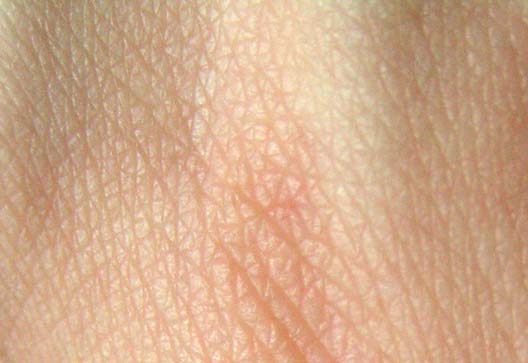
Human skin
The human skin is the outer covering of the body and is the largest organ of the integumentary system. The skin has up to seven layers of ectodermal tissue guarding muscles, bones, ligaments and internal organs. Human skin is similar to most of the other mammals' skin, and it is very similar to pig skin. Though nearly all human skin is covered with hair follicles, it can appear hairless. There are two general types of skin: hairy and glabrous skin (hairless). The adjective cutaneous literally means "of the skin" (from Latin cutis, skin).
This article is about skin in humans. For other vertebrates, see Skin.Human skin
Skin plays an important immunity role in protecting the body against pathogens and excessive water loss. Its other functions are insulation, temperature regulation, sensation, synthesis of vitamin D, and the protection of vitamin B folates. Severely damaged skin will try to heal by forming scar tissue. This is often discoloured and depigmented.
In humans, skin pigmentation (affected by melanin) varies among populations, and skin type can range from dry to non-dry and from oily to non-oily. Such skin variety provides a rich and diverse habitat for the approximately one thousand species of bacteria from nineteen phyla which have been found on human skin.
Cell count and cell mass[edit]
Skin cell table[edit]
The below table identifies the skin cell count and aggregate cell mass estimates for a 70 kg adult male (ICRP-23; ICRP-89, ICRP-110).[14][15][16]
Tissue mass is defined at 3.3 kg (ICRP-89, ICRP110) and addresses the skin's epidermis, dermis, hair follicles, and glands. The cell data is extracted from 'The Human Cell Count and Cell Size Distribution',[17][18] Tissue-Table tab in the Supporting Information SO1 Dataset (xlsx). The 1200 record Dataset is supported by extensive references for cell size, cell count, and aggregate cell mass.
Detailed data for below cell groups are further subdivided into all the cell types listed in the above sections and categorized by epidermal, dermal, hair follicle, and glandular subcategories in the dataset and on the dataset's graphical website interface.[19] While adipocytes in the hypodermal adipose tissue are treated separately in the ICRP tissue categories, fat content (minus cell-membrane-lipids) resident in the dermal layer (Table-105, ICRP-23) is addressed by the below interstitial-adipocytes in the dermal layer.